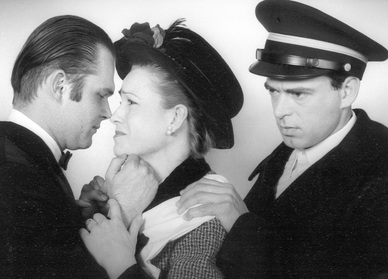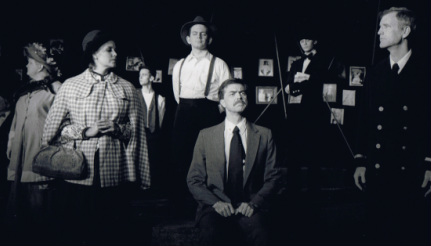A fascinating stage play by Michael Wehrli

Buddy Myers Photo: Patrick Shackleford, Kelli Hagen, Phillip Davis
OVERVIEW:
On April 14th, 1912 the lives of 2,200 families were forever changed along with the attitude of the modern world. The sinking of the Titanic was a seminal event in the early 20th century that shaped the way we looked at technology and mankind’s abilities to “conquer nature”. The tragedy also typified the immense gap between the classes in the so called “Gilded” age. Furthermore, the disaster showed how striving for immense profits while not assessing the huge risks being taken - as is the case with many tragedies of this kind - were at the heart of the problem. The stage play Titanic Aftermath focuses on these issues through the eyes of the tragedy’s survivors and its key players.
The play has been scrupulously researched with the goal of being the most accurate artistic portrayal of the Titanic tragedy.
Titanic Aftermath is a stage play that involves 19-25 actors playing over 110 roles. For specific casting requirements, please scroll down. With the exception of the four primary characters, the lines spoken by the survivor characters are based on a direct quote from that time. Also, all the information and facts noted in the dialogue are factual, based on our current understandings. The original production was viewed by two Titanic Historians and Muffet Laurie Brown, the great-granddaughter of Margaret "Molly" Brown. All three said it was the most accurate portrayal of the Titanic’s story they had seen in a dramatic medium. Please click here to see more testimonials regarding the play and the script.
Click here to see a promotional video! A one act version is also available. Contact us for more information.
SYNOPSIS:
Based on the Senate Hearing transcripts, the British Inquiry and survivor accounts, the play is told through the eyes of J. Bruce Ismay, president of the White Star Line at the time of the disaster. He is now near the end of his life in mental anguish over his role in the disaster after having spent twenty five years in seclusion. He is still unable to come to terms with his and White Star’s culpability. His nights are spent in torment reliving the event and hearing the voices from the past. Enter the spirits of three who did not survive the disaster - an Officer of the Titanic, a First Class Woman Passenger, and a Third Class Woman Passenger. They visit him in his last desperate hours in order to confront him with the truths about his company’s role in the tragedy and force him to relive that fateful night through the testimonials of the survivors.
J. Bruce Ismay is taken on a sweeping journey towards absolution. Guided by the First Class Woman, the Third Class Woman, and the Officer, Ismay relives the heat of the Senate Hearings and British Inquiry. Ismay and company are taken to task on several of the mistruths, outright lies and overall whitewashing that came out of the hearings. Furthermore, he is forced to bear witness and relive the infamous night itself through the most personal stories of the survivors. His own inner journey involves coming to terms with his own deeply felt guilt and his continuing sorrow over the tragedy. With the help of the other characters, he slowly becomes aware of the great lessons to be learned from the tragedy.
On another level, the play examines the role of huge corporations whose risk management decisions directly lead to the disaster. Many revelations are brought out in this highly researched play. We learn that Titanic was far from being state-of-the-art in safety features. The audience also discovers that the very corporations which owned the huge liners also controlled how the industry was regulated. Not surprisingly, they decided that profit and luxury trumped the need for complete safety. Unfortunately this is a theme that continues to resonate today.
On April 14th, 1912 the lives of 2,200 families were forever changed along with the attitude of the modern world. The sinking of the Titanic was a seminal event in the early 20th century that shaped the way we looked at technology and mankind’s abilities to “conquer nature”. The tragedy also typified the immense gap between the classes in the so called “Gilded” age. Furthermore, the disaster showed how striving for immense profits while not assessing the huge risks being taken - as is the case with many tragedies of this kind - were at the heart of the problem. The stage play Titanic Aftermath focuses on these issues through the eyes of the tragedy’s survivors and its key players.
The play has been scrupulously researched with the goal of being the most accurate artistic portrayal of the Titanic tragedy.
Titanic Aftermath is a stage play that involves 19-25 actors playing over 110 roles. For specific casting requirements, please scroll down. With the exception of the four primary characters, the lines spoken by the survivor characters are based on a direct quote from that time. Also, all the information and facts noted in the dialogue are factual, based on our current understandings. The original production was viewed by two Titanic Historians and Muffet Laurie Brown, the great-granddaughter of Margaret "Molly" Brown. All three said it was the most accurate portrayal of the Titanic’s story they had seen in a dramatic medium. Please click here to see more testimonials regarding the play and the script.
Click here to see a promotional video! A one act version is also available. Contact us for more information.
SYNOPSIS:
Based on the Senate Hearing transcripts, the British Inquiry and survivor accounts, the play is told through the eyes of J. Bruce Ismay, president of the White Star Line at the time of the disaster. He is now near the end of his life in mental anguish over his role in the disaster after having spent twenty five years in seclusion. He is still unable to come to terms with his and White Star’s culpability. His nights are spent in torment reliving the event and hearing the voices from the past. Enter the spirits of three who did not survive the disaster - an Officer of the Titanic, a First Class Woman Passenger, and a Third Class Woman Passenger. They visit him in his last desperate hours in order to confront him with the truths about his company’s role in the tragedy and force him to relive that fateful night through the testimonials of the survivors.
J. Bruce Ismay is taken on a sweeping journey towards absolution. Guided by the First Class Woman, the Third Class Woman, and the Officer, Ismay relives the heat of the Senate Hearings and British Inquiry. Ismay and company are taken to task on several of the mistruths, outright lies and overall whitewashing that came out of the hearings. Furthermore, he is forced to bear witness and relive the infamous night itself through the most personal stories of the survivors. His own inner journey involves coming to terms with his own deeply felt guilt and his continuing sorrow over the tragedy. With the help of the other characters, he slowly becomes aware of the great lessons to be learned from the tragedy.
On another level, the play examines the role of huge corporations whose risk management decisions directly lead to the disaster. Many revelations are brought out in this highly researched play. We learn that Titanic was far from being state-of-the-art in safety features. The audience also discovers that the very corporations which owned the huge liners also controlled how the industry was regulated. Not surprisingly, they decided that profit and luxury trumped the need for complete safety. Unfortunately this is a theme that continues to resonate today.
CASTING REQUIREMENTS:

Photo by Buddy Myers.
Principals -
J. Bruce Ismay: Man. 74.
First Class Passenger: Woman (Edith Evans). 30s.
Third Class Passenger: Woman. 20s.
Officer: Man (James P. Moody). 20s.
Ensemble -
7-10 Women (ages 20-50) playing 40 roles
8-11 Men (ages 20-60) playing 70 roles
Titanic Aftermath is published by Engelhardt Publishing Company. ISBN 9780615460925
For performance rights, please Contact Us.
To purchase a BOOK VERSION of the PLAY, please Click Here.
A one-act version of the play is also available.
J. Bruce Ismay: Man. 74.
First Class Passenger: Woman (Edith Evans). 30s.
Third Class Passenger: Woman. 20s.
Officer: Man (James P. Moody). 20s.
Ensemble -
7-10 Women (ages 20-50) playing 40 roles
8-11 Men (ages 20-60) playing 70 roles
Titanic Aftermath is published by Engelhardt Publishing Company. ISBN 9780615460925
For performance rights, please Contact Us.
To purchase a BOOK VERSION of the PLAY, please Click Here.
A one-act version of the play is also available.